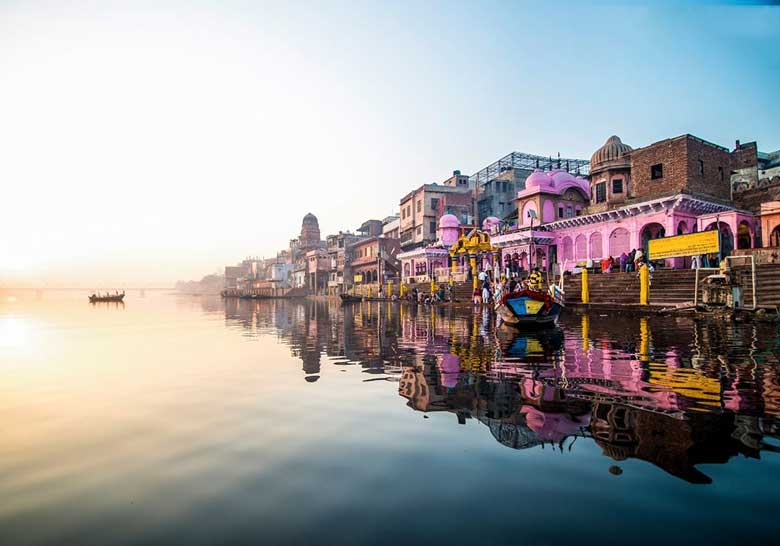Places to Visit in Mathura and Vrindavan
Delhi to Mathura and Vrindavan – The road between Delhi and Agra once passed through a more ancient and venerated city than either — Mathura and neighbouring Vrindavan. Mathura was known to the Greeks as Madoura ton theon (Mathura of the Gods). It was the second capital of the Kushan empire (1st-3rd century AD). Pilgrims like Fahsein (5th century AD) and Hsuan Tsang (7th century AD), and travellers like Tavernier (1650) and Father Tieffenthaler (1754), amongst others, journeyed to this area and recorded its cultural and religious importance. Its prosperity and accessibility was an invitation to plunderers like Mahmud of Ghazni (AD 1017) and others. But today, the busy traveller flies over it by air and by-passes it on the road—which is a pity, because Mathura and Vrindavan are quintessential Indian towns, where the life of the people is as much on display as their monuments. In this respect they resemble other pilgrimage centres in India, like Varanasi in Uttar Pradesh or Pushkar in Rajasthan. However, they contain no extraordinary examples of architecture — though as an ensemble certain parts of the town, especially the river front, do achieve a certain grandeur.
Where is Mathura and Vrindavan?
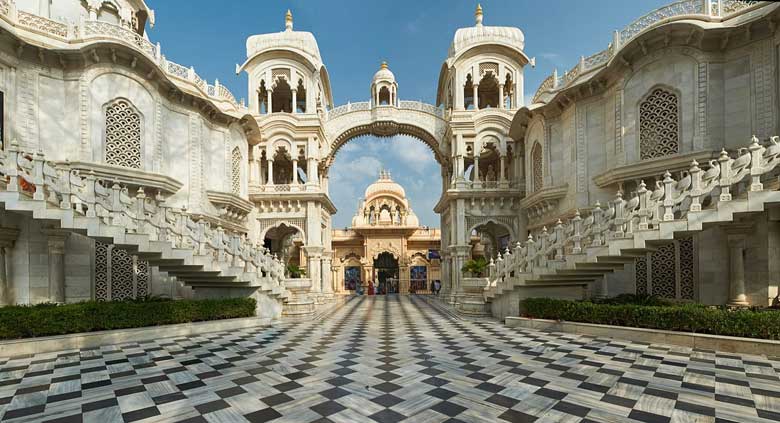
Vrindavan
Mathura and Vrindavan lie in the heart of a region known as Brajbhumi —the Land of Braj. Geographically, it is an area roughly 70 km (44 miles) long and 45 km (28 miles) wide, straddling the river Yamuna. Culturally, it is the holy land of Vaishnava Hinduism, whose followers propitiate Vishnu, the Protector in the Hindu trinity. This is the hallowed region where, incarnate as Krishna, he lived and played. Krishna, besides ridding the world of evil, revealed the Bhagvadgita, the preeminent Hindu scriptural text, during the epic battle of Kurukshetra narrated in the Mahabharata. His dalliances with the milkmaids of Vrindavan inspired some of the finest lyrical poetry, music and painting in the country. His worship in Mathura and Vrindavan is conducted by means of communal pilgrimages to all the sacred spots associated with his life, and by the chanting of the mahamantra — the great mantra:
- Hare Krishna, Hare Krishna,
- Krishna Krishna, Hare Hare,
- Hare Rama, Hare Rama,
- Rama, Rama, Hare Hare.
A visit to the land of Braj will not be memorable for visits to monuments but for experiencing its vibrant living culture. Mathura and Vrindavan are, therefore, different from better known sites of architectural importance or even Shaivite religious centres like Varanasi. Here the devotion of the people to the story of Krishna is palpable.
Places to Visit in Mathura
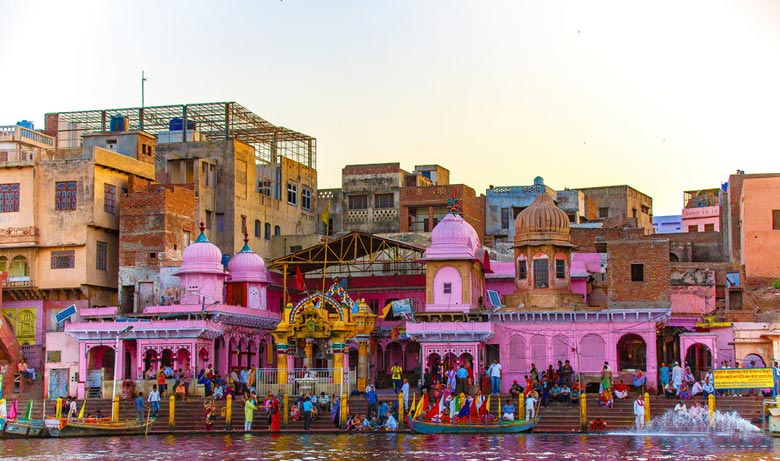
Mathura Tourist Attractions
Most of contemporary Mathura is only a few centuries old, though tradition maintains that it is a very ancient site indeed. Although a Hindu centre, the earliest verifiable references to Mathura are of Buddhist or Jain origin. Gautama Buddha died in 477 BC and is known to have established institutions in Mathura during his lifetime, but Krishna is believed to have preceded him by several centuries. However, there is only inferential evidence to support this belief. The Vedas, Puranas and the epics, which were finally compiled around AD 400, possibly reflect the state of affairs existing in North India from about the 10th century BC, at the time when Krishna is associated with this region.
Historical evidence of Mathura is available from about 2,500 years ago, during the Buddhist hegemony over this region, and comes into focus at the time of the Kushans, Indo-Bactrian rulers who had convened to Buddhism and held sway over this area in the wake of Alexander’s conquests. Their rule introduced Hellenistic aesthetics into Indian art. The Kushans who followed the Sakas made Mathura their winter capital and wholeheartedly patronized Buddhism. This patronage was reflected in the flowering of the arts and emergence of which is known as the Mathura School. The most famous Kushan ruler, Kanishka, started an era in AD 78 known as the Saka era, which is used by the Government of India in its official calendar.
Being on the trade routes and with strong royal patronage, Mathura developed into an important commercial and cultural centre. The Mathura school of art was prolific in its output and is recognised by its products made of local red and buff-coloured sandstone. While the images of Buddha were influenced by the Graeco-Roman style introduced by the Kushan rulers through their empire, the work of this school strongly retained its indigenous characteristics. At present the Mathura Museum possesses the largest collection of sculptures and other artefacts produced in this style in India. Besides beautiful images of Buddha and Buddhist themes, the Chinese pilgrims mention seeing a vast complex of stupas and religious institutions, of Which only fragmentary evidence now remains. The archaeological excavations at Sonkh near Mathura offer significant evidence of the existence of this culture.
Some time after this period, Mathura regained its Hindu antecedents, except for occasional periods of religious persecution. The epics which were compiled during this period naturally reflected the politics of their times, and it is conjectured that Krishna owes such of his present lustre to the gratitude of the Brahmans, who under his banner recovered their ancient influence. Today there is little doubt that the Vaishnava culture is deeply embedded in the consciousness of the people of Brajbhumi Each village hill or pond is associated with the boyhood events of Krishna’s life. The source of this belief is the Bhagvat Purana, traditionally ascribed to the grammarian Bopadeva who lived in the 12th or 13th century AD. Places to Visit in Mathura & Vrindavan…
One cannot understand contemporary Mathura or Vrindavan without knowing this ancient story.
The Legend: Over 3,000 years ago, King Kansa usurped the throne of Mathura and began a tyrannical reign from which his subjects prayed for deliverance. A prophecy told Kansa that his nemesis would be the son of his sister Devaki and her husband Vasudev. He incarcerated the couple and slew every child born to them in prison; but on the night of Krishna’s birth, Vasudev managed to smuggle him out through divine intervention, putting him under the care of the cowherd Nanda and his wife Jasoda in Gokul, across the river from Mathura.
Krishna grew up with his foster-parents and became known throughout the countryside for his supernatural feats, and also for his mischievous pranks like stealing butter and enchanting the milkmaids with the divine music he played on the flute. Radha was his favourite, and their various assignations at Vrindavan have added countless embellishments to the basic story.
Kansa heard of this extraordinary cowherd and recognised the fated avenger. He invited Krishna to a tournament in the hope of forestalling providence, but Krishna defeated all corners and finally slew Kansa. He dragged the tyrant’s body to the banks of the Yamuna for creation and at last “rested” at a place still known as Vishram Ghat or the Resting Ghat. This is the holiest spot in Mathura.
After accomplishing this mission, Krishna spent his adulthood in Dwarka, in Western India, and took part in the great war described in the Mahabharata, but his association with Mathura had ended. In Mathura, Vrindavan and other places linked with his boyhood, however, people implicitly believe in his continued presence. It is this faith that mixes history and myth into the everyday life of Brajbhumi.
Tourist Places to Visit in Vrindavan
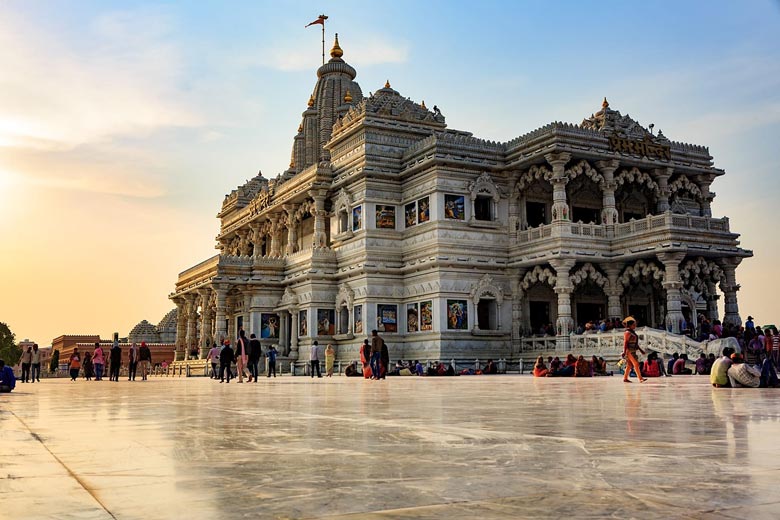
Tourist Places to Visit in Vrindavan
The Sacred Forest: Vrindavan means a forest of vrinda or tulsi (basil) plants. The forest cover consisted of the Kadamba tree. Both plants have a special significance for Vaishnavas and almost every Hindu grows a tulsi shrub at home which is ritually worshipped every day. Unlike other tirthas (pilgrimage destinations) of India, Vrindavan was in essence a forest, not a city. Ancient documents listing principal places of pilgrimage understandably did not mention it, though Mathura is identified as an important tirtha. Places to Visit in Mathura & Vrindavan…
When Chaitanya (1486-1533) — the great Vaishnava saint from Bengal primarily associated with the emergence of the Krishna cult — visited Vrindavan, it was a forest. It is believed that he instructed his followers to establish temples here. Sanatana and Rupa, two of his disciples from Bengal, erected the first shine, of which no trace remains, and also became the first priests of the Govind Deva temple. (It fell into disuse after the image of the deity was removed to Jaipur to escape Aurangzeb in the 17th century, and only recently has another image been installed.) Gopal Bhatt from South India established the Radha Raman temple, and his descendants have served the deity ever since. The image of Krishna in this temple is notable for having remained in Vrindavan for the longest continuous period of time. It escaped the notice of the iconoclast Aurangzeb because it is only 30 cm (12 inches) tall. Places to Visit in Mathura & Vrindavan…
The other impetus to the development of the town was provided by the emperor Akbar. It is said that Akbar wanted to meet the saint Hari Das, who had been the guru of his court musician, Tansen, and invited him to Agra. Hari Das sent a message back to the effect that he preferred to attend the court of his Lord. Thus, it was Akbar who made the pilgrimage in 1573, and in honour of that event four temples were duly erected — Govind Deva, Gopinath, Jugal Kishore and Madan Mohan.
Vrindavan has a population of about 40,000, but several times that number visit the town as tourists and pilgrims. It is also a place where Vaishnavites in their old age take refuge, especially widows. To die in Vrindavan, it is believed, is to be guaranteed moksha, release from the cycle of rebirth. The town, therefore, has several dharamsalas or pilgrim rest houses and widow-houses, donated and maintained by rich merchants from around the country as an act of piety.
Vrindavan was once a river-oriented town and had several ghats or steps leading to the river edge. The river gradually receded, leaving dry many of the 38 ghats along the 2.5-km (1Y2-mile) river front. In fact only five ghats are actually on the water. The town has a tightly knit fabric and is on slightly undulating land with well paved roads which drain the surface wastes to the river. Like most other traditional towns, open sewers run on the sides of these streets, polluting the diminishing waters in the river.
The Kesi and Pandawala Ghats located at the extreme northeast are important pilgrimage points. The buildings along these Ghats are imposing, with exquisite workmanship in the traditional style, loosely referred to as the Jat style of architecture.
Important amongst the several temples of the town are the Govind Deva and Radha Balabh, built in the 16th and 17th centuries, and the Rangji and Shahji, built during the latter half of the 19th century.
Mathura Today
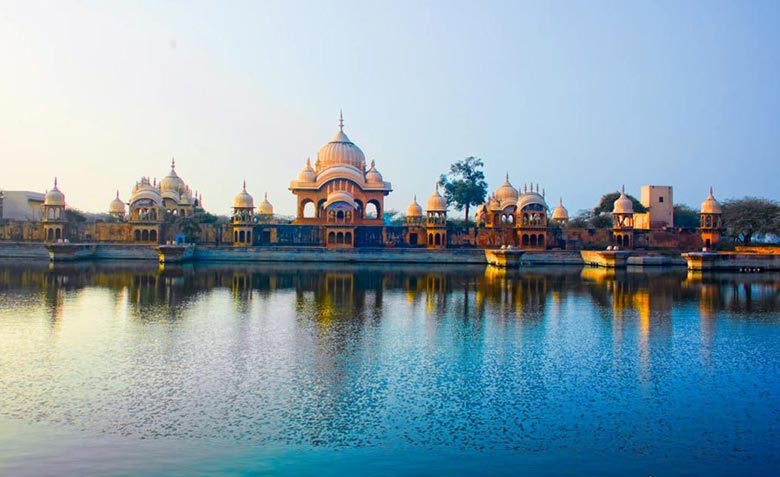
Explore Mathura
Mathura: The modern town of Mathura has a population of around 250,000. With the location of a large oil refinery and other industries nearby, the profile of the population is becoming heterogenous, but it is still a city that has a strong sense of its traditions, with the lives of its people revolving around the cycle of festivals and religious rituals. There are 36 major festivals that fill the town with activity throughout the year.
In spite of its antiquity, Mathura is a relatively new town. After Mahmud of Ghazni in 1017, the town was sacked again by Nadir Shah in 1739 and Ahmad Shah in 1757. It was the Marathas and the Jat rulers of Bharatpur who began rebuilding the Mathura we see today. The town has a delightfully organic character with a strongly defined edge along the river. Unlike the deserted ghats of Vrindavan, those of Mathura are alive with activity. There are steps leading to the water, temples, residences, shops, dharamsalas and sacred trees. Pilgrims and locals mingle with sacred cows, monkeys and turtles. The most used stretch is between Vishram Ghat and the Sati Burj built in 1527 by the Raja of Jaipur to commemorate the self-immolation of his mother. Others claim that it was built to commemorate the sati of the wife of a local citizen, Behari Mal. In any case, it is an unusual monument with an incongruous dome on top. At Vishram Ghat the corpses are “rested” before being carried through the bazaar to the cremation grounds south of the bridge.
Dwarkadhish, built in 1914 in the heart of the city, is its most important temple. The Jama Masjid, also in the heart of the city, was built over the ruins of the Keshav Deo temple in 1661. This temple had been built fifty years earlier to mark the site of Kansa’ s prison where Krishna was born. Tavernier, who visited it in 1650, considered it “one of the most sumptuous edifices in all India”. Delhi to Mathura & Vrindavan…
However, a visit to Mathura is not about a search for great works of architecture. One has to look beyond the typically anarchic traffic and bustle of activity, to witness the numerous festivals which fill the ritual calendar of Mathura.
Festivals of Mathura & Vrindavan
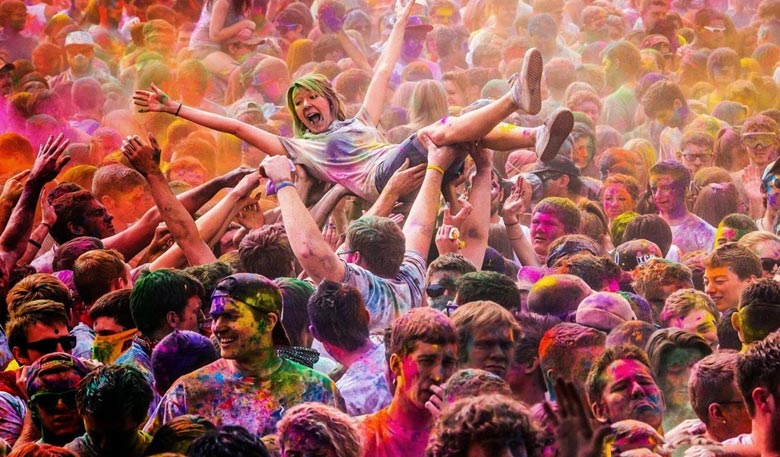
Holio in Mathura & Vrindavan
Festivals: Pilgrims come to Mathura and Vrindavan throughout the year and undertake the ritual parikrama or circumambulation as an act of piety. The parikrama can encompass a few important shrines or the entire Brajbhumi, which takes several days to complete. They usually start with a ritual bath at the Vishram Ghat and end there too. Interestingly, even though a ritual bath at the end of the pilgrimage would be a welcome necessity, most pilgrims avoid it because they believe that it may wash away the merit acquired during the parikrama.
There are many special days like the Panama (full moon) and Ekadasi (11th day of the moon’s cycle) which are considered auspicious and draw crowds. Other prominent festivals include Holi (February—March) and Janamashtami (August—September), the birthday of Krishna. During Holi, the festival of colour, people intoxicate themselves with bhang and sing and dance in celebration. It is the Indian saturnalia. At Barsana, Radha’s hometown, an amusing spectacle is enacted: a fight between the men from the neighbouring village of Nandgaon and the women of Barsana during which the men are heated with wooden poles, accompanied by ribald rhymes.
On Janamashtami, parikramas are undertaken and the ras-lila is celebrated. Ras-lilas are religious dance-dramas which represent the most popular incidents in the life of Krishna. The complete cycle extends over a month and each scene is enacted on the very spot with which the original episode is traditionally connected, known as ras-mandals. The troupe is lead by a guru who teaches the players. The parts of Krishna and the gopis are taken by young Brahman boys who, for the devotees in the audiences, become the living embodiments of the deity.
If one were to list all the festivals that are celebrated, it would appear that there is time for little else; life here appears to be one long series of rituals and devotion. Unlike in other tirthas, people come here not to facilitate their journey to the other world, but to be caught in the tide of ecstasy of faith, and thereby find tranquility in this life. To an outsider, it is part of the great charm of Brajbhumi.
Mathura Museum
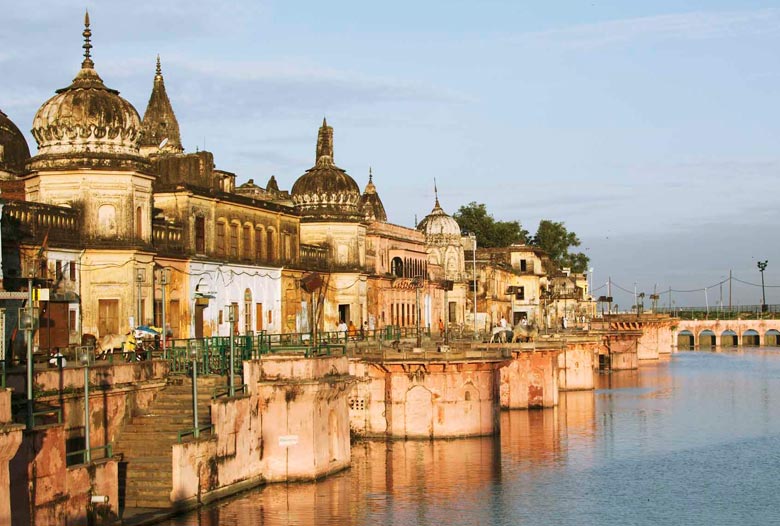
Mathura Museum
The Government Museum in Mathura is an important regional museum. It contains a definitive collection of the Mathura school which flourished in this region about 2,000 years ago and was seminal to the development of Indian art. Curiously, in an area steeped in Krishna bhakti (devotion), the pride of the collection is its examples of traditional art and sculptures with Jain or Buddhist themes.
There was little concrete evidence of these local cultures until 1837 when accidental discoveries made during excavations for new construction in the vicinity of Mathura alerted the nascent British colonial administration to its existence. Archaeology in India was in its pioneering phase at this me, and Sir Alexander cunningham, the first rector General of the haeological Survey India, and several others, made substantial discoveries.
In 1874, F.S. Growse, a sympathetic scholar as well as a colonial administrator, decided to stem the out-flow of Indian art treasures to museums in Britain by establishing a museum in Mathura. It was known as the Curzon Museum for Archaeology until 1973.
While the cultures of this region produced a variety of artefacts, the Museum collection is built around its terracotta and sandstone sculptures. The terracotta collection reveals more clearly the development of sculptural technique. There is a significant difference between the earlier mother-goddesses (4th century BC) whose anatomical features were created by pinching the clay and whose ornamentations were punch-marked, and the works of the Sunga period (2nd to 1st century BC) when the clay was skilfully molded as in the 1st century BC Kamadeva. These skills developed further when, sandstone became preferred medium of expression, as can be seen in the beautiful 4th century Kartikeya.
Mathura is best known for its sandstone sculpture in the style identified as the Mathura school. The city was a well known culture centre from the time of Buddha and, being on the trade routes, it became a melting-pot where local and external artistic traditions mingled and were synthesised into a distinct regional style, particularly during the Kushan period (1st to 3rd century BC).
The Kushans had an empire stretching from Afghanistan to Bihar. Mathura was their winter capital and provided generous patronage to the arts in this region. The Kushan art of Mathura was, however, totally different from the Kushan art of Gandhara where the Hellenic influence was noticeably strong. The Mathura school was a continuation of the indigenous traditions of Bharhut and Sanchi. The Yakshis in the museum display indigenous aesthetic traditions — notice the triple flexion or tribangha peculiar to Indian art. The representations of Buddha evolved from these traditions had round faces, full lips and monastic robes and were very different from the “Apollonian” Buddha of the Gandhara region of northwestern South Asia.
The Mathura school is recognised for two major innovations. Firstly, it fused the traditional arts of the local people with the parallel court traditions based on the Iranian and Indo-Bactrian traditions of the ruling elite. This created new iconographic formulae for both Buddhist and Hindu iconic art which were followed in later Indian statuary. Secondly, it replaced the symbolic worship of Buddha by his image in human form, and this revolutionised the development of art in India.
These developments reached their climax during the Gupta period between AD 325 and 600. Thereafter, the sculptures from this school display greater formality, heavier ornamentation and more complex groupings, as seen in the 10th century seated Vishnu and standing Surya. With the rise of Brahmanism, the themes naturally changed to reflect religious beliefs.
With the emergence of Krishna as the titular deity of Mathura, however, one wonders why this tradition of expression ceased and why the artists of this region moved to other media when there was such a wealth of sculptural skill.
For more information on Mathura & Vrindavan Tours contact Swan Tours – One of the leading Travel Agents in India, Some links which would give information on Delhi, Jaipur, Agra, Mathura and Vrindavan:
